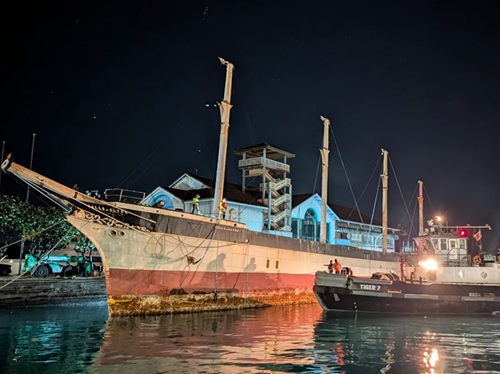Governor Larry Hogan (R) and the Maryland Board of Public Works recently approved contracts with two Maryland companies to make bricks, pavers, concrete highway barriers, and shoreline supports – among other structures – from the dredged material cleared from one of the Port of Baltimore’s shipping channels.
[Above photo by the Port of Baltimore.]
“We’ve used this sediment for years to rebuild islands, create wildlife habitats and reinforce shorelines,” explained Greg Slater, secretary of the Maryland Department of Transportation, in a statement.

“These new proposals could lead to new and innovative reuse of dredged materials to benefit the community and the environment.”
The Maryland Port Administration – a division of the Maryland DOT – explained that dredge sediment is regularly cleared from shipping channels to provide easier ship navigation. In the past, the dredge sediment byproduct helped restore Hart-Miller Island in Baltimore County and Poplar Island in Talbot County, with the Barren and James islands in Dorchester County currently slated for reconstruction over the next several years using dredged sediment.
“The Maryland Port Administration is known for its innovative use of dredged material to restore land and create environmental assets,” noted Governor Hogan in a separate statement. “Dredging is necessary for the Port of Baltimore to accommodate the huge ships that deliver cargo and grow our economy.

Pending permits, restoration at Barren Island could begin in 2022, with the James Island following in 2024. The Maryland DOT said those projects – conducted in collaboration with the U.S. Army Corps of Engineers – would deposit an estimated 90 million to 95 million cubic yards of dredged sediment at James Island, providing at least 30 years of capacity. Meanwhile, Barren Island would accept sediment from nearby shallow-draft channels.
“Our experience working with the Army Corps of Engineers at Poplar Island gives us great optimism for what we can accomplish together at Mid-Chesapeake Bay,” Maryland DOT Secretary Slater said.

“This restoration will rebuild two vanishing islands and help protect Maryland’s critical shorelines. It also demonstrates, yet again, how dredged material can be a valuable resource to support the [Chesapeake] Bay environment and the men and women working at [Baltimore’s] port.”
William Doyle, director of the Maryland Port Administration, added that the new contracts seeking to turn dredged material into other structural products would help further its sediment-recycling efforts.
“We’re excited to partner with these companies to test the ability to reuse sediment for productive purposes,” he explained.
“This allows us to continue removing dredged sediment from our channels to maintain the 50-foot depth needed to accommodate the supersized vessels that bring cargo and jobs to the Port of Baltimore while recycling that sediment to use again in other ways – a real win-win.”
 States
States
Hawaii DOT Disposes of Historic ‘Falls of Clyde’ Ship
October 24, 2025 States
States

